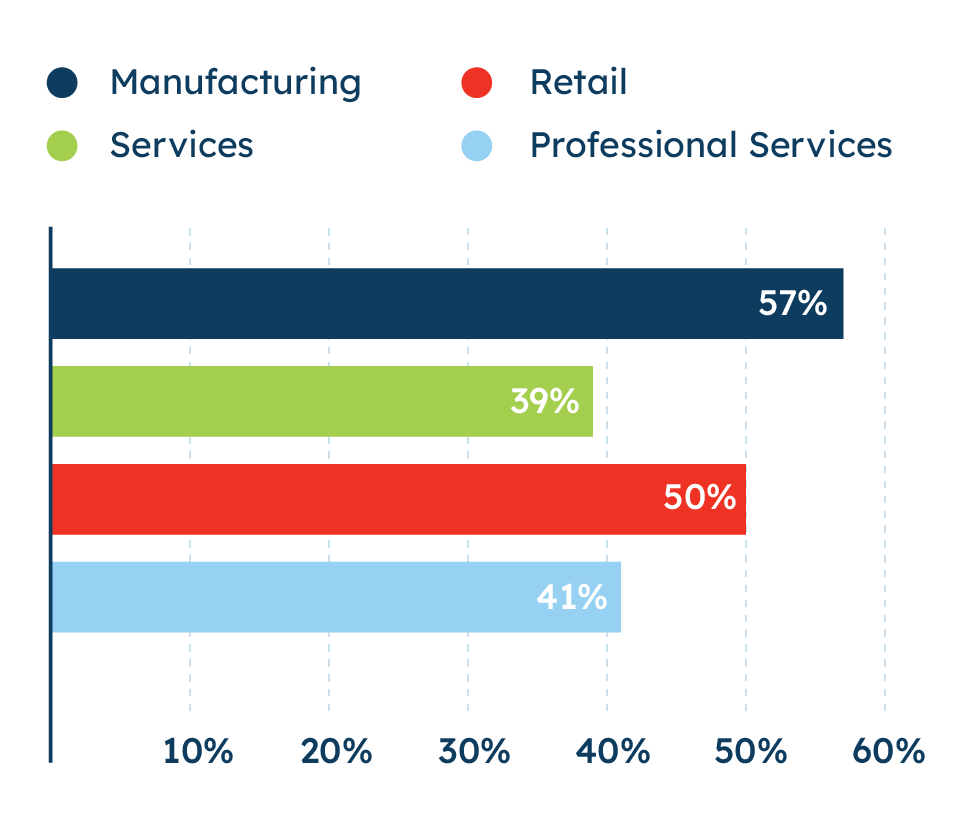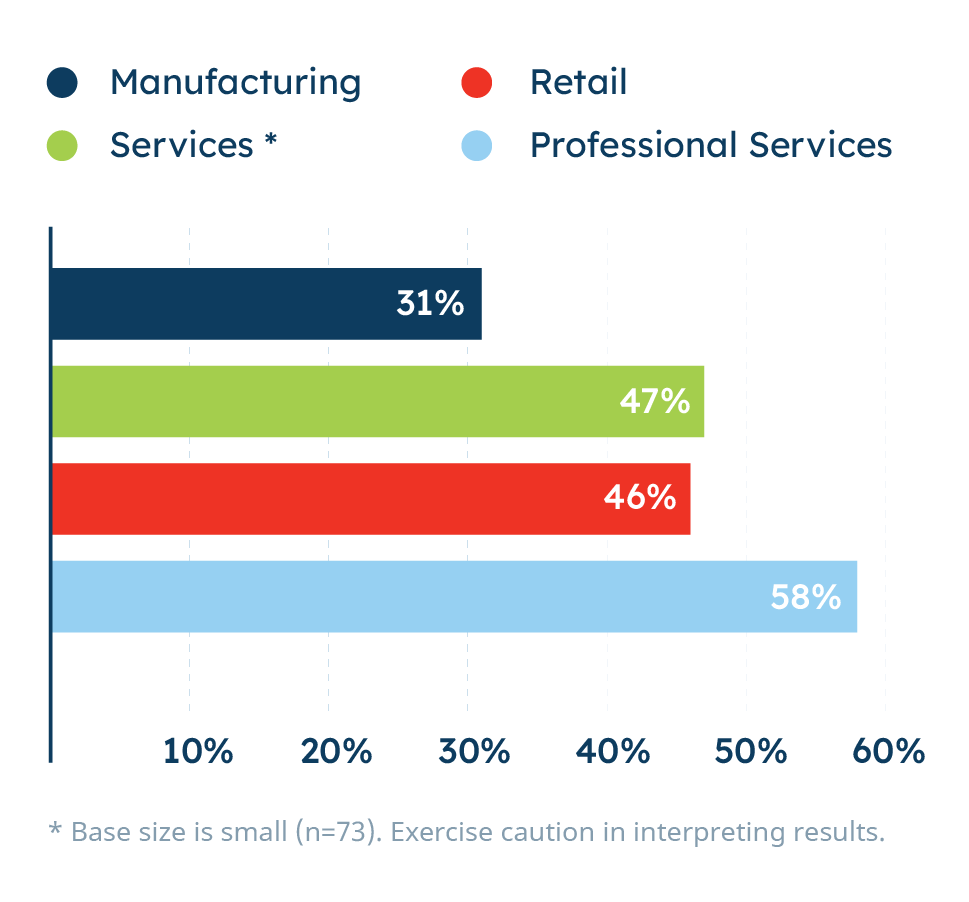Inflation Tops List of Concerns for Eighth Consecutive Quarter

Worries about affording employee healthcare and benefits grow
In Q1 2022, inflation replaced revenue as the single top concern among small business owners with 33% saying it was a top concern. Since then, inflation concerns have grown and plateaued: A majority of small businesses (53%) say inflation is the top challenge facing the small business community. This is also the sixth quarter in a row where 50% or more have cited inflation as their biggest challenge.
Inflation concerns continue to exist regardless of a small business’s region, number of employees, or sector. However, small businesses in the services sector are more likely than those in manufacturing or professional services to say inflation is their biggest challenge (61% vs. 48% and 47%, respectively). About half (54%) of small businesses in retail say the same.
Other concerns don’t come close to inflation. About one-fifth of small business decision makers say either revenue (22%) or rising interest rates (19%) are the biggest challenges facing them right now. Each of these levels is relatively unchanged from Q3 2023.
In addition, supply chain issues are less a concern than they used to be. Small businesses said supply chain issues are their fourth most challenging issue with 17% saying it’s a top concern. This is down from a peak of 28% who said it was a top concern in Q2 2022.
A growing concern is containing the cost of employee benefits. Concerns around affording employee benefits or healthcare have increased by seven percentage points since the start of the year to 17% saying it’s a top concern. There is a clear upward trend when compared to the beginning of the year when only 10% said affording employee benefits or healthcare was a top concern. Business size matters here: affording employee benefits and healthcare is the second most challenging issue reported among small businesses with 20-500 employees.
This quarter, 12% of small businesses each say that employee retention or employee well-being/morale are top concerns. Small businesses have expressed fairly consistent sentiments about these two measures since the question was first asked in Q3 2021.

Jam Hops, Ham Lake, Minnesota
Most small businesses see a worker shortage in their area
About half of small businesses who have searched for new talent in 2023 say it is hard to find candidates with the experience (54%) or skills (52%) they need for the job. When compared to September 2021, when this question was last asked, the net difficulty in finding candidates has increased significantly. Small businesses say that finding workers with the necessary experience (up a net 19 percentage points), finding candidates in their area (up net 14 percentage points), and finding enough candidates to fill open positions (up net 11 percentage points) have all become more difficult.
Additionally, a majority (53%) of all small businesses say there is a worker shortage in their area. Small businesses that report searching for new talent in 2023 are even more likely to say there is a worker shortage in their area than those who have not searched for new talent this year (63% vs. 44%, respectively). Also, almost half (48%) of small businesses who have searched for talent in 2023 say it is hard to find enough candidates to fill open positions.
Furthermore, 71% of small businesses who say it is hard to fill open positions say they feel there is a worker shortage in their area, emphasizing the impact of this perceived shortage on the hiring process and the difficulty of finding the right workers.


More small businesses are looking for new workers
As with reported increases in staffing in the past year, small businesses are more likely to report having searched for new talent in 2023 if they are male-owned or have more employees. Many (78%) large small businesses (20-500 employees) report seeking workers this year—while only 33% of those with 1-4 employees report the same.
Small manufacturers and retailers are the most hungry for workers. Manufacturers (57%) and retailers (50%) are more likely than services (39%) or professional services (41%) to say that they’ve searched for or interviewed new talent this year.


Many look to flexible and remote work to attract employees
Amidst these reported challenges to hiring—amplified by reported worker shortages and difficulties offering competitive pay and benefits to attract new talent—44% of small businesses also say they think that their business needs to change its hiring strategies in 2024. And many are reporting plans to do just that.
Offering flexible work hours is the top way small businesses hope to attract talent in 2024. Nearly seven in ten (68%) small businesses say they plan to offer more flexible working hours in the next year. Similarly, 48% say they plan to offer hybrid or remote working environment options. Also, 67% of small businesses surveyed report currently offering employees the ability to work remotely/from home at least once per week.
Regardless of business size or sector, the majority of small businesses report planning to offer more flexible working hours to attract new talent. Those with 5-19 employees, however, are more likely than the smallest (fewer than five employees) and largest (20-500 employees) small businesses to plan to do so. Small businesses in the professional services sector (75% offering flexible hours) are more likely to say they plan to do this than those in the manufacturing sector (58% offering flexible hours). Still, in all sectors at least a majority of small businesses report offering flexible work hours.
When it comes to planning to offer a hybrid or remote work environment to attract new talent in the next year, small businesses in the professional services sector and those owned by Gen Zers or millennials are especially likely to say they will offer a hybrid or remote work environment to attract talent in the next year.
Small businesses are using other methods to attract workers. Half (50%) of small businesses report that they plan to increase pay offerings, offer paid sick leave, or list the hourly pay or salary range in job descriptions to attract talent in the next year.


Most say it’s hard keeping up with employee salary expectations
It's also hard to keep up with the demands of new workers. Almost half (46%) of small businesses who say they have searched for new talent in 2023 say it is hard to offer competitive pay and benefits to attract new talent. Among those searching for talent and saying it is hard to fill open positions, even more agree (60%).
This self-reported difficulty in offering competitive pay and benefits to attract talent is particularly pronounced for the smallest small businesses (those with less than five employees). By sector, small businesses in professional services are more likely (58%) to say it is difficult to offer competitive pay and benefits to attract new talent compared to those in manufacturing (31%); those in services (47%) and retail (46%) fall in the middle.

Sonic Promos, Gaithersburg, Maryland
A majority say the country should issue more skilled worker visas
With the increased difficulty finding the right workers and enough candidates for job openings, small businesses are searching for ways to find employees who may have been previously overlooked. Specifically, small businesses are looking at women, legal immigrants, and historically-overlooked talent pools to help fill the gap.
Finding affordable child care is one of the biggest barriers to working, so some small businesses are offering some kind of reimbursement for childcare to expand their hiring pool to parents, and mothers in particular, to ultimately fill hiring gaps amid perceived worker shortages. Businesses owned by Gen Zers or millennials (33%), businesses that have 20-500 employees (35%), or businesses planning to hire in 2023 (34%) are especially likely to say they plan to provide childcare reimbursement in the next year.
A majority of small businesses say the country should accept more skilled, legal immigrants to meet their staffing needs. Over half (54%) of small businesses say they agree that the U.S. should issue more skilled worker visas each year so businesses can hire the workers they need. The latter of these statements, about skilled worker visas, is particularly important to small businesses who report having a worker shortage in their area: 67% of them say the U.S. should offer more skilled worker visas, while just 39% of small businesses who do not report a worker shortage agree.
Many also believe small businesses should look more widely for workers. A majority (71%) of small businesses agree that employers should more often consider hiring from overlooked talent pools, such as formerly incarcerated people, veterans, military spouses, or legal immigrants.

Using social networks and professional referrals remain the top ways for small businesses to find new talent this year.
Of the small businesses who report having searched for new talent in 2023, two-thirds (66%) say they used social networks, such as LinkedIn, to search for candidates, and about half (54%) say they have asked professional contacts and/or current employees for referrals. These were also the top methods recorded in June 2021 and Q4 2018, when this question was previously asked.
The second tier of hiring strategies for those who have searched for candidates in 2023 includes promoting the benefits offered (35%), using a recruiter (32%), and attending professional networking events or leveraging professional memberships (30%). Compared to June 2021, small businesses who report looking for talent in 2023 are now more likely to say they have searched for candidates by attending professional networking events or school/college events or career fairs – something that could not be done in the height of the pandemic.

Small businesses report plans to hire seasonal workers this year
Fewer small businesses report planning to hire seasonal employees for the upcoming holiday season this year versus in Q4 2022 and Q4 2021 (19% vs. 28% and 29%, respectively).
Small businesses in the retail sector are more likely than those in the services or professional services sector to say they plan to hire seasonal employees (28% vs. 17% and 10%, respectively). One-quarter of those in the manufacturing sector say the same.
A majority (74%) of small businesses who say they plan to hire seasonal employees continue to report that they plan to offer hiring incentives or bonuses to attract them.


